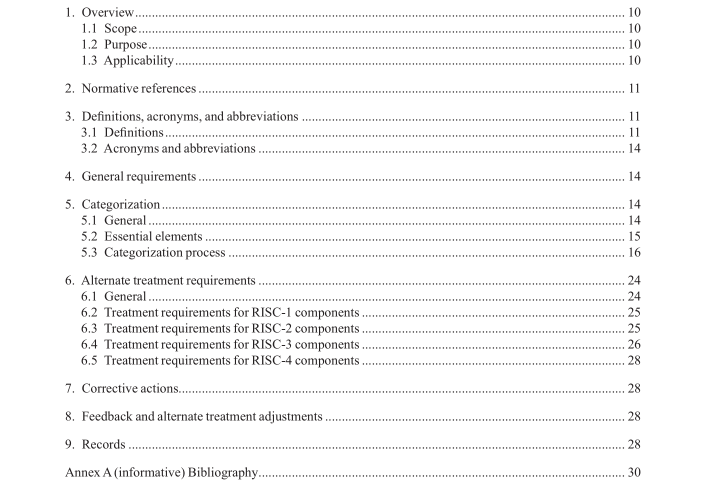IEEE 1819-2016 pdf download.IEEE Standard for Risk-Informed Categorization and Treatment of Electrical and Electronic Equipment at Nuclear Power Generating Stations and Other Nuclear Facilities
reasonable confdence: A level of confdence based on facts, actions, knowledge, experience, and/or observa- tions, which is deemed to be adequate. Reasonable confdence is a lower level of confdence than reasonable assurance. risk: Probability and consequences of an event, as expressed by the answer to the following three questions1) What can go wrong2) How likely is it and 3) What are the consequences if it occurs Risk-Informed Safety
Classifcation -1 (RISC-1): Electrical and electronic systems and components (EE- SCs) that are Class 1E and that the risk-informed categorization process determines are signifcant contribu- tors to plant safety. RISC-1 EESCs perform their safety-signifcant functions consistent with the categoriza- tion process, including those safety-signifcant functions that go beyond the functions defned as Class 1E for which credit is taken in the categorization process. (EESCs that are Class 1E and perform safety-signifcant functions.)
Risk-Informed Safety Classifcation -2 (RISC-2): Electrical and electronic systems and components (EE- SCs) that are defned as non-Class 1E, although the risk-informed categorization process determines that they are signifcant contributors to plant safety on an individual basis. Though some RISC-2 EESCs may not have existing special treatment requirements, the focus for RISC-2 EESCs is on the safety-signifcant functions for which credit is taken in the categorization process. (EESCs that are non-Class 1E and perform safety-signif- cant functions.)
Risk-Informed Safety Classifcation -3 (RISC-3): Electrical and electronic systems and components (EE- SCs) that are defned as Class 1E, although the risk-informed categorization process determines that they are not signifcant contributors to plant safety. Special treatment requirements may be reduced for RISC-3 EESCs and replaced with alternate treatments.
These alternate treatments are intended to provide reasonable conf- dence that these EESCs can perform their Class 1E functions under design-basis conditions, albeit at a reduced level of assurance compared to the current special treatment requirements. (EESCs that are Class 1E and per- form low safety-signifcant functions.)
Risk-Informed Safety Classifcation -4 (RISC-4): Electrical and electronic systems and components (EE- SCs) that are defned as non-Class 1E, and that the risk-informed categorization process determines are not signifcant contributors to plant safety. (EESCs that are non-Class 1E and perform low safety-signifcant functions.) safety signifcant: Syn: high safety signifcant.
safety signifcant function: A function whose degradation or loss could result in a signifcant adverse efect on defense-in-depth, safety margin, or risk. sensitivity studies: Analyses that are performed to verify that assumptions or uncertainties made in the proba- bilistic risk assessment are not masking the importance of an electrical and electronic system and component.
Typical sensitivity studies include increasing human error rates, removal of common cause failures, increasing maintenance unavailabilities, and increasing the failure rate of low safety signifcant components. special treatment requirements: Current regulatory requirements imposed on structures, systems, and components that go beyond industry-established (industrial) controls and measures for equipment classifed as commercial grade and are intended to provide reasonable assurance that the equipment is capable of meeting its design basis functional requirements under design basis conditions. These additional special treatment requirements include design considerations, qualifcation, change control, documentation, reporting, mainte- nance, testing, surveillance, and quality assurance requirements.
testing: The act of verifying that component performance satisfes expected results or parameters.
3.2 Acronyms and abbreviations
CDF core damage frequency
CFR United States Code of Federal Regulations
EESC electrical and electronic systems and components
FTC fail to close (and remain closed)
FTO fail to open
F-V Fussell-Vesely importance measure
HSS high safety signifcant or safety signifcant
IDP integrated decision making panel
LERF large early release frequency
LSS low safety signifcant or not safety signifcant
MCC motor control center
NEI Nuclear Energy Institute
NRC U.S. Nuclear Regulatory Commission
PRA probabilistic risk assessment
PSA probabilistic safety assessment
RAW risk achievement worth importance measure
RG U.S. NRC Regulatory Guide
RISC Risk-Informed Safety Classifcation.IEEE 1819 pdf download.IEEE 1819-2016 pdf download
IEEE 1819-2016 pdf download

Leave a Reply